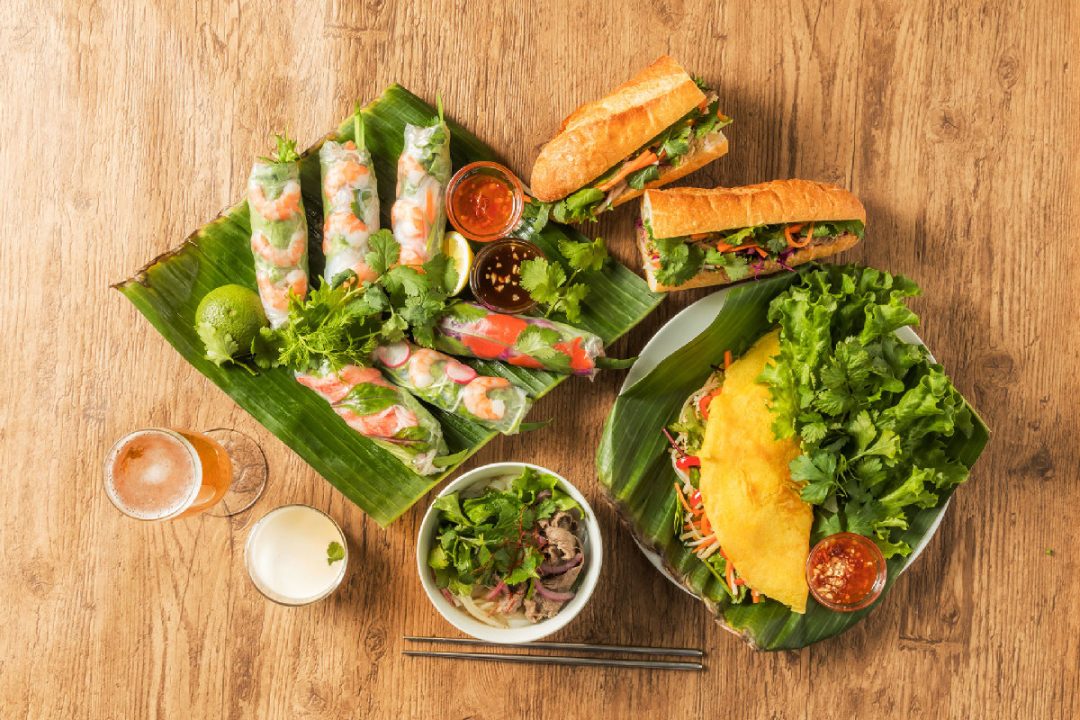越南是一个美食天堂,拥有多样化、美味的美食,反映了该国丰富的历史和文化影响。从芳香四溢的河粉到美味的越南三明治,越南美食提供了一系列诱人的风味,即使是最挑剔的味蕾也会感到满意。在这篇博文中,我们将深入探讨这个迷人的世界 越南菜,揭示其历史、标志性菜肴、独特的食材和文化意义。
越南菜的历史
越南的烹饪传统受到多种因素的影响,包括地理位置、外国影响和文化多样性。该国悠久的贸易和殖民历史在塑造其美食方面发挥了重要作用,从而实现了风味和烹饪技术的和谐融合。
古老的起源
越南美食的起源可以追溯到古代文朗王国和悠乐王国,那里的湿稻种植奠定了该国农业实践的基础。这些早期文明在很大程度上依赖于当地种植的食材,如大米、鱼以及各种香草和香料,为当今越南美食的充满活力的风味奠定了基础。
中国影响
在长达一千年的中国统治时期,越南菜吸收了中国烹饪的影响。这种文化交流将炒菜、筷子的使用以及酱油和米粉等技术引入越南菜肴中。
法国殖民影响
19 世纪末开始的法国对越南的殖民统治在该国的烹饪景观上留下了不可磨灭的印记。法式三明治中法棍的使用、肉酱和蛋黄酱的加入,以及法式面包和法式面包等糕点的烘焙技术的采用,都可以看出法国的影响。
越南的热门菜肴
越南菜以其口味、质地和香气的和谐平衡而闻名。以下是一些最受欢迎和标志性的菜肴,它们已成为越南烹饪传统的代名词。
河粉
河粉可以说是最著名的越南菜肴,它是一种俘获了全世界人民的心和味蕾的面条汤。这道标志性菜肴的特色是米粉、切成薄片的牛肉或鸡肉、新鲜香草,以及用八角茴香、肉桂和丁香等香料慢炖数小时的美味肉汤。
面包
Banh mi 是一种越南风格的三明治,是一种深受喜爱的街头小吃,展示了法国和越南烹饪影响的融合。这种便携式美食的特色是酥脆的法棍面包,里面充满了猪肉、肉酱、腌菜以及一系列新鲜香草和酱汁等美味食材。
Goi Cuon(新鲜春卷)
Goi cuon(即新鲜春卷)是一种受欢迎的越南开胃菜,集中体现了美食的新鲜和健康。这些精致的卷充满了粉丝、新鲜香草和各种配料,如虾、猪肉或蔬菜,全部包裹在半透明的米纸包装中,并配有美味的蘸酱。
越南烹饪中使用的独特食材
越南菜的特点是使用独特的食材,为菜肴带来独特的风味和香气。以下是使越南食品脱颖而出的一些最著名的成分:
鱼露(Nuoc Mam)
鱼露,或 nuoc mam,是越南烹饪的主要成分。这种辛辣的酱汁由发酵凤尾鱼、盐和水制成,可为许多菜肴增添浓郁的风味,通常用作蘸酱或调味料。
新鲜香草
越南菜大量采用新鲜香草,如香菜、薄荷、罗勒和 rau ram(越南香菜),为菜肴增添了充满活力的风味和香气。这些香草不仅是装饰,而且是提升膳食整体味道和复杂性的重要组成部分。
辣椒
新鲜和干辣椒在越南美食中发挥着重要作用。它们为许多菜肴增添了令人愉悦的热量和浓郁的风味,从汤、炒菜到蘸酱和调味品。
越南街头小吃文化
越南以其充满活力的街头美食文化而闻名,摊贩在每个角落都提供一系列美味且价格实惠的美食。从熙熙攘攘的市场到路边摊,街头美食是越南人日常生活中不可或缺的一部分,也是任何烹饪爱好者的必去体验。
受欢迎的街头小吃
一些最受欢迎的越南街头食品包括:
- Banh mi(越南三明治)
- Banh xeo(越南脆皮薄饼)
- Bun cha(烤猪肉配面条)
- Goi cuon(新鲜春卷)
- Banh trang nuong(烤米纸卷)
街头美食之旅
许多城市在 越南提供街头美食之旅,让游客探索当地的美食场景并品尝不同供应商的各种菜肴。这些游览提供身临其境的体验,让您深入了解每道菜背后的文化、历史和传统。
越南传统烹饪技术
越南美食的特点是一系列代代相传的传统烹饪技术。这些技术不仅造就了菜肴独特的风味和质感,也体现了越南人民的文化遗产和聪明才智。
Nuoc Mam(鱼露)准备工作
准备 nuoc mam(即鱼露)是越南的一项历史悠久的传统。这种基本成分是通过用盐发酵凤尾鱼或其他小鱼制成的,使混合物陈化数月甚至数年,以形成其独特的风味和香气。
烧烤和烟熏
烧烤和烟熏是越南美食中常用的技术,特别是在准备肉类和海鲜菜肴时。这些方法为食材增添了独特的烟熏风味和嫩滑的质地,创造出 thit nuong(烤猪肉)和 ca nuong(烤鱼)等菜肴。
蒸
蒸是越南美食中一种健康而精致的烹饪方法,通常用于准备 banh bao(馒头)和 banh cuon(蒸肠粉)等菜肴。这项技术有助于保留成分的天然风味和营养成分,同时创造细腻的质地。
法国殖民统治对越南美食的影响
法国对越南的殖民统治从 19 世纪末一直持续到 20 世纪中叶,对该国的烹饪格局产生了深远的影响。这种文化交流导致了法国和越南烹饪传统的融合,产生了如今已成为越南美食不可或缺的独特菜肴和风味。
面包和糕点
越南美食中广泛使用法棍面包和糕点,可以看出法国的影响。 banh mi(越南三明治)和 bánh patê sô(越南 pâté chaud)等菜肴展示了这种融合,将法式面包和肉酱与越南风味和食材相结合。
乳制品
虽然传统上不属于越南美食的一部分,但法国人引入了黄油、奶油和奶酪等乳制品,现在它们被用于各种菜肴和甜点中。例如,bánh flan(越南焦糖奶油)和 bánh su kem(越南泡芙糕点)就融入了这些法国风味的原料。
咖啡文化
法国人还将对咖啡的热爱带到了越南,从而带动了越南蓬勃发展的咖啡文化。越南咖啡通常搭配炼乳,已成为当地人和游客喜爱的饮料。
越南食品的健康益处
越南菜不仅美味,而且由于注重新鲜食材、口味平衡以及保留菜肴营养价值的烹饪技术,因此具有一系列健康益处。
富含抗氧化剂
许多越南菜肴都含有新鲜的香草和蔬菜,它们富含抗氧化剂,有助于保护身体免受自由基和氧化应激的侵害。香菜、薄荷和辣椒等成分是抗氧化剂的极好来源。
低脂肪
越南菜往往脂肪含量较低,因为它严重依赖鱼和家禽等瘦肉蛋白,以及蔬菜和香草。传统的烹饪方法,如蒸和烧烤,进一步减少了对添加油或脂肪的需求。
富含益生菌
发酵食品,如 nuoc mam(鱼露)和腌菜,在越南美食中很常见。这些发酵食品富含益生菌,可以促进健康的肠道微生物组并改善整体消化健康。
越南用餐礼仪
越南的用餐礼仪反映了该国丰富的文化遗产和传统。了解和尊重这些习俗可以增强您的用餐体验并表现出对当地文化的尊重。
家庭式用餐
在越南,家庭式用餐很常见,菜肴放在桌子中央供大家分享。在为自己服务之前先为他人服务,并使用餐具而不是自己的筷子或勺子从公共菜肴中取食物被认为是有礼貌的。
筷子礼仪
筷子是越南的主要餐具,使用时有一定的礼仪规则。把筷子直插在米饭上是不礼貌的,因为这就像给死者上香一样。相反,当您不吃饭时,请将筷子水平放在碗的顶部。
敬酒习俗
在越南与他人共餐时,喝酒前通常会敬酒。餐桌上最年轻或资历最浅的人通常会主动敬酒,并且习惯上在喝一口之前与在场的每个人碰杯。将自己的酒杯举得比年长或地位较高的人的酒杯低是有礼貌的。
越南菜的地区差异
越南多样化的地理环境和丰富的文化历史造就了不同地区的美食差异,每种美食都有其独特的风味、食材和烹饪风格。从北部高地到南部湄公河三角洲,探索这些区域差异可以让您更深入地了解越南的烹饪传统。
北方美食
越南北部美食以其微妙的风味和融合中国烹饪的影响而闻名。菜肴通常以淡水鱼、猪肉以及各种香草和蔬菜为特色。受欢迎的菜肴包括河粉(面条汤)、Bun Cha(烤猪肉配面条)和 Cha ca(姜黄鱼配莳萝)。
中央美食
越南中部美食的特点是辛辣和大胆的口味,受到前皇家首都顺化的影响。该地区的菜肴通常以辣椒、柠檬草和虾酱为特色。一些标志性菜肴包括 Bun bo Hue(辣牛肉面汤)和 banh khoai(脆米粉煎饼)。
南方美食
越南南部美食以其更甜和更热带的风味而闻名,反映了湄公河三角洲丰富的水果和蔬菜。椰奶、甘蔗和新鲜香草常用于 goi cuon(新鲜春卷)、com tam(碎米)和 huieu(猪肉海鲜汤面)等菜肴中。
越南著名的食品市场
食品市场是越南烹饪文化的重要组成部分,提供充满活力和熙熙攘攘的环境,当地人和游客都可以在这里品尝新鲜农产品、街头小吃和地方特色菜。参观这些著名的食品市场提供了一种感官体验,让游客沉浸在越南的景色、声音和风味中。
滨城市场(胡志明市)
滨城市场是胡志明市最古老、最著名的市场之一,提供各种各样的商品,包括新鲜农产品、肉类、海鲜和街头小吃摊。游客可以品尝河粉、越式三明治和新鲜热带水果等当地美食,同时购买纪念品和手工艺品。
同春市场(河内)
同春市场是河内最大的室内市场,位于历史悠久的老城区。这个熙熙攘攘的市场是一座迷宫般的狭窄小巷,挤满了出售新鲜农产品、香料、服装和电子产品等各种商品的摊贩。游客可以在市场的小吃摊品尝传统的河内菜肴,如 Bun Cha 和 banh cuon。
会安中央市场(会安)
会安中央市场是一个充满活力、色彩缤纷的市场,位于会安古镇的秋盆河附近。该市场以其新鲜的海鲜、香草和纺织品而闻名,街头小吃摊还供应草捞(面条)和白玫瑰饺子等当地特色菜。游客还可以参加烹饪课程和市场参观,以了解更多关于越南食材和美食的信息。
结论
总之,越南菜是口味、质地和香气的和谐融合,反映了该国丰富的文化遗产和多样化的地区影响。从河粉和越南三明治等受欢迎的菜肴到鱼露和新鲜香草等独特的食材, 越南菜 提供既令人满意又营养丰富的美食体验。街头美食文化、传统烹饪技术和法国殖民影响都增强了越南美食的深度和复杂性,使其成为全球美食爱好者的最爱。无论是探索胡志明市熙熙攘攘的食品市场,还是品尝会安的地方特色菜,越南的美食景观一定会让所有享受美食的人感到愉悦和鼓舞。




